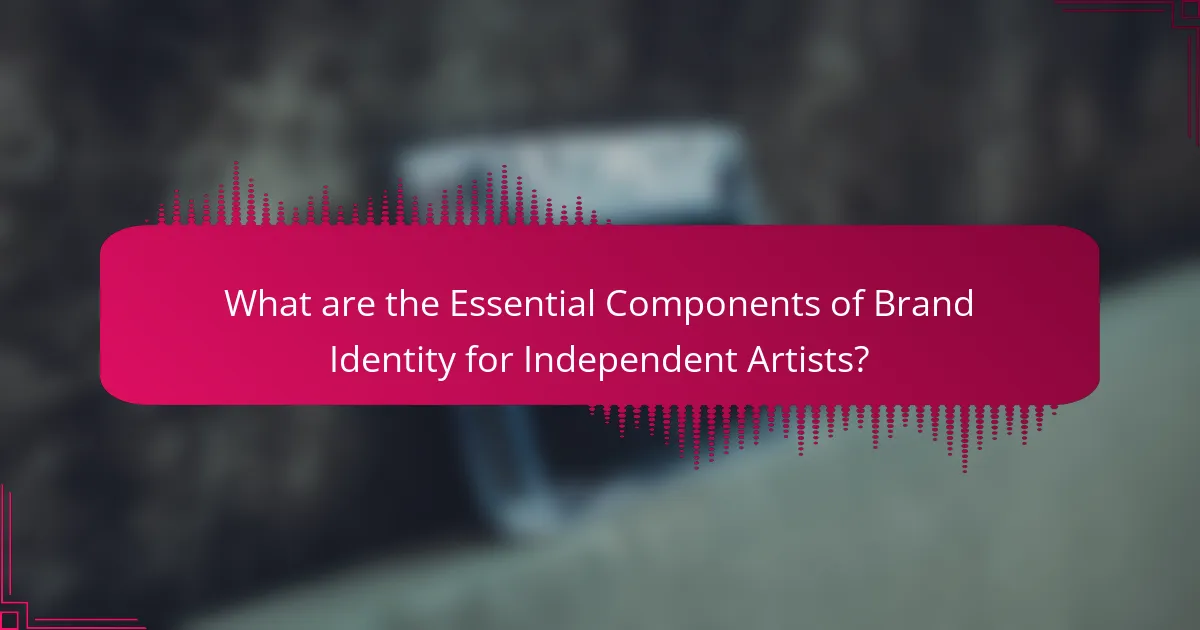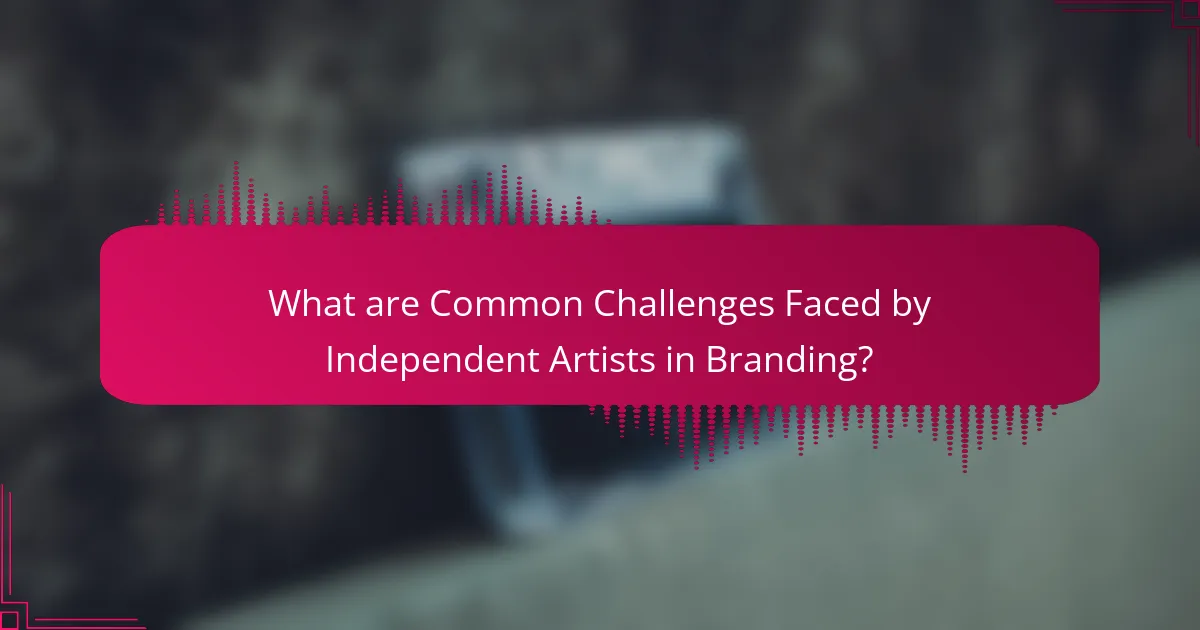Building a strong brand identity is crucial for independent artists seeking to connect with their audience and stand out in a competitive market. Key elements include establishing a visual identity, crafting compelling brand messaging, and engaging with fans through social media. Artists must identify their unique positioning and cultural influences to create authentic connections. Consistent communication and adaptation of their brand strategy are essential for long-term success.

What are the Essential Components of Brand Identity for Independent Artists?
Brand identity for independent artists includes visual elements, messaging, and audience engagement strategies. Key components are consistent branding, unique storytelling, and authentic connection with fans.
1. Visual Identity: This encompasses logos, color schemes, and typography that reflect the artist’s style and genre.
2. Brand Messaging: Clear and compelling narratives about the artist’s journey, values, and music create emotional resonance.
3. Audience Engagement: Building a community through social media interactions, live performances, and fan feedback fosters loyalty.
4. Unique Positioning: Identifying what sets the artist apart helps in crafting a distinctive brand that attracts attention.
How do Visual Elements Influence Artist Branding?
Visual elements significantly shape artist branding by creating a memorable identity. Effective use of colors, typography, and imagery helps convey an artist’s unique style and message. For instance, consistent visual themes across platforms enhance recognition and build a cohesive brand narrative. Engaging visuals can evoke emotions and connect with audiences, fostering loyalty and a sense of community.
What Role Does Storytelling Play in Brand Identity?
Storytelling is essential in shaping brand identity for independent artists. It creates emotional connections, enhances relatability, and differentiates the artist in a crowded market. Through narratives, artists convey values, experiences, and authenticity, fostering loyalty among audiences. Engaging stories can transform a simple brand into a compelling identity that resonates deeply with fans.
Why is Consistency Important in Branding?
Consistency is crucial in branding because it builds trust and recognition. A cohesive brand identity fosters familiarity, making it easier for audiences to connect with independent artists. Consistent messaging across platforms reinforces the artist’s values and vision, enhancing their credibility. This reliability encourages audience loyalty, which is essential for long-term success.

How Can Independent Artists Define Their Unique Value Proposition?
Independent artists can define their unique value proposition by identifying their distinct style, target audience, and core message. This clarity helps them stand out in a crowded market.
First, artists should analyze their creative strengths and unique attributes, such as their artistic techniques or themes. Next, they must understand their audience’s preferences and pain points, ensuring their work resonates with potential fans. Finally, a compelling narrative around their art can enhance emotional connection, making their value proposition more engaging and memorable.
By focusing on these elements, independent artists can craft a strong brand identity that effectively communicates their unique offerings.
What Factors Contribute to an Artist’s Unique Style?
An artist’s unique style is shaped by personal experiences, influences, and techniques. Key factors include cultural background, artistic influences, and experimentation with various mediums. Personal narrative plays a significant role, as it informs the themes and emotions conveyed in their work. Additionally, consistency in visual elements, such as color palette and composition, solidifies an artist’s identity in the eyes of their audience.
How Do Personal Experiences Shape Brand Identity?
Personal experiences significantly shape brand identity by influencing how independent artists connect with their audience. These experiences create authenticity, fostering emotional engagement and loyalty. Artists’ unique journeys inform their narratives, allowing them to stand out in a crowded market. By sharing personal stories and insights, they cultivate a relatable brand that resonates with fans. This connection enhances brand recognition and builds a community around shared values and experiences.

Which Strategies are Effective for Building a Brand Presence Online?
Effective strategies for building a brand presence online include creating a strong visual identity, engaging with the audience through social media, and maintaining consistent messaging. Independent artists should leverage platforms like Instagram and TikTok to showcase their work and connect with fans. Collaborating with other artists can enhance visibility and credibility. Additionally, utilizing SEO techniques can improve discoverability across search engines. Engaging storytelling around the artist’s journey can foster deeper connections with the audience, making the brand more relatable.
What Social Media Platforms are Best for Independent Artists?
Independent artists should focus on platforms like Instagram, TikTok, and Bandcamp to build their brand identity effectively. Instagram offers visual storytelling, TikTok enables creative video content, and Bandcamp provides direct sales opportunities. Each platform has unique attributes that cater to different artistic expressions and audience engagement strategies.
How Can Artists Leverage Content Marketing for Branding?
Artists can leverage content marketing to enhance their brand identity by creating authentic narratives that resonate with their audience. They should focus on storytelling, showcasing their creative process, and sharing behind-the-scenes content, which builds connection and trust. Engaging visuals and consistent messaging across platforms reinforce their unique artistic voice. Additionally, collaborating with other creators can expand their reach and diversify their content. Regularly analyzing audience engagement metrics helps refine strategies and ensures alignment with their brand goals.

What are Common Challenges Faced by Independent Artists in Branding?
Independent artists face various challenges in branding, including limited resources, lack of marketing knowledge, and difficulty in creating a unique identity. These factors hinder their ability to effectively reach and engage their target audience.
Resource constraints often lead to inadequate funding for promotional activities, which impacts visibility. Additionally, many independent artists struggle with understanding branding principles, making it hard to develop coherent strategies.
Creating a unique identity is another challenge, as artists must differentiate themselves in a saturated market. This requires consistent messaging and visual elements that resonate with their audience.
Finally, maintaining brand consistency across different platforms can be difficult, leading to mixed messages that confuse potential fans. Addressing these challenges is crucial for effective brand building.
How Can Artists Overcome Limited Resources in Branding?
Independent artists can overcome limited resources in branding by leveraging creativity and strategic partnerships. Focusing on a clear brand identity helps convey their unique attributes effectively. Utilizing social media platforms allows artists to reach audiences without significant financial investment. Collaborating with other creatives can expand visibility and share resources. Engaging in community events enhances local presence and builds a loyal fan base. Lastly, creating quality content consistently fosters brand recognition and strengthens the artist’s narrative.
What Impact Does Market Saturation Have on Brand Identity?
Market saturation can dilute brand identity by increasing competition and making differentiation challenging. Independent artists must emphasize unique attributes to stand out. A strong brand identity fosters loyalty and recognition, essential in crowded markets. Strategies like storytelling and authentic engagement help maintain a distinct presence.

How Do Cultural Differences Affect Artist Branding Strategies?
Cultural differences significantly influence artist branding strategies by shaping identity, messaging, and audience engagement. Understanding cultural nuances allows artists to create authentic connections with diverse audiences.
For example, in Western cultures, individualism may drive branding focused on personal narratives. In contrast, collectivist cultures might emphasize community and shared experiences in branding.
Artists can also tailor their visual aesthetics to resonate with cultural symbols and values, enhancing relatability. Adapting marketing channels based on cultural preferences further optimizes outreach.
Ultimately, effective branding for independent artists hinges on recognizing and integrating cultural diversity into their strategies, ensuring relevance and resonance across various demographics.
Which Approaches Resonate with Audiences in Different Regions?
Different regions respond to brand identity approaches based on cultural values and preferences. Tailoring strategies to local nuances enhances resonance and engagement.
| Region | Approach | Key Element | Strategy Example |
|—————–|—————————————|———————————–|—————————–|
| North America | Personal storytelling | Authenticity | Share artist’s journey |
| Europe | Visual aesthetics | Design coherence | Consistent branding visuals |
| Asia | Community connection | Collective identity | Engage with local groups |
| Latin America | Emotional appeal | Passion and vibrancy | Use vibrant colors and music |
| Africa | Cultural heritage | Tradition and storytelling | Incorporate local folklore |
| Australia | Humor and relatability | Casual approach | Use light-hearted content |
What Role Does Local Culture Play in Brand Development?
Local culture significantly influences brand development by shaping identity, values, and customer connections. Understanding local customs and preferences allows independent artists to create authentic branding that resonates with their audience. This cultural alignment fosters loyalty and enhances brand recognition. Engaging with local narratives and traditions can differentiate a brand in a competitive market, making it more relatable and appealing. By incorporating local elements into their strategies, artists can build a strong, culturally relevant brand identity.

What are the Best Practices for Maintaining Brand Identity Over Time?
To maintain brand identity over time, independent artists should consistently communicate their unique values and aesthetic. Regularly engage with their audience through social media and events, ensuring that their message remains clear and authentic.
Visual elements, such as logos and color schemes, should be used consistently across platforms to reinforce recognition. Additionally, artists must adapt their strategies based on feedback and market trends while staying true to their core identity.
Establishing a strong narrative around their journey and artistic vision helps to build a lasting connection with fans. Regularly revisiting and refining their brand story keeps it relevant and engaging.
How to Adapt Brand Identity Without Losing Core Values?
To adapt brand identity without losing core values, focus on consistency and authenticity. Maintain your foundational principles while evolving visual elements and messaging. Engage with your audience to ensure alignment with their expectations, reflecting their feedback in your adaptations. Regularly assess your brand’s perception to stay true to your core values amid changes.
What Common Mistakes Should Artists Avoid in Branding?
Independent artists should avoid common branding mistakes to create a strong identity. Failing to define a unique style can lead to confusion. Neglecting audience engagement diminishes connection. Inconsistent messaging undermines credibility. Overlooking professional visuals can harm perception. Ignoring feedback limits growth.
How Can Independent Artists Measure the Success of Their Brand Identity?
Independent artists can measure their brand identity success through audience engagement, social media metrics, and brand recognition. Tracking follower growth, interaction rates, and feedback helps gauge the effectiveness of branding efforts. Consistent visual and messaging elements contribute to a recognizable identity, while collaboration and community involvement enhance visibility. Regularly assessing these factors informs necessary adjustments to strengthen brand positioning.
What Expert Tips Can Help Artists Strengthen Their Brand Identity?
To strengthen their brand identity, artists should focus on consistency, authenticity, and audience engagement. Consistent visual elements, such as logos and color schemes, create recognition. Authentic storytelling fosters deeper connections with fans. Engaging with the audience through social media and interactive content builds loyalty and community.



